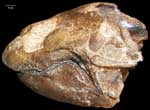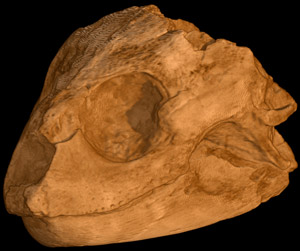Literature
Batsch, A. J. G. C. 1788. Versuch einer Anleitung, zur Kennnish und Geschichte der Thiere und Mineralien. Akademische Buchhandlung, Jena, 528 pp.
Baur, G. Notes on the classification of the Cryptodira. American Naturalist 27:672-675.
Bottjer, D. J. 1985. Trace fossils and paleoenvironments of two Arkansas Upper Cretaceous discontinuity surfaces. Journal of Paleontology 59:282-298.
Brinkman, D. B. 1993. Ordosemys leios, n.gen., n.sp. a new turtle from the Early Cretaceous of the Ordos Basin, Inner Mongolia. Canadian Journal of Earth Sciences 30:2128-2138.
Brinkman, D. B. 2000. A primitive cheloniid from the Campanian (Late Cretaceous) of Alberta, Canada. Journal of Vertebrate Paleontology 20(3, Supplement):31A.
Brinkman, D. B. 2005. A vertebrate assemblage from the marine shales of the Lethbridge Coal Zone. Pp 486-500 in P. J. Currie and E. B. Koppelhus (eds.) Dinosaur Provincial Park, A
spectacular ancient ecosystem revealed. Indiana University Press, Bloomington and Indianapolis, Indiana.
Brinkman, D. B., and E. L. Nicholls. 1993. The skull of Neurankylus eximius (Testudines: Baenidae) and a reinterpretation of the relationships of this taxon. Journal of
Vertebrate Paleontology 13:273-281.
Brinkman, D. B., and J. –h. Peng. 1993. New material of Sinemys (Testudines, Sinemydidae) from the Early Cretaceous of China. Canadian Journal of Earth Sciences 30:2139-2152.
Brinkman, D. B., and X. C. Wu. 1999. The skull of Ordosemys, an Early Cretaceous turtle from Inner Mongolia, People's Republic of China, and the interrelationships of Eucryptodira (Chelonia, Cryptodira). Paludicola 2:134-147.
Case, E. C. 1898. Toxochelys. University of Kansas Geological Survey 4:370-385.
Cobban, W. J., and W. J. Kennedy. 1993. Upper Cretaceous ammonites from the Coon Creek
Tongue of the Ripley Formation at its type locality in McNarry County, Tennessee. U. S.
Geological Survey Bulletin 2073: B1-B12.
Collins, R. E. L. 1951. A new turtle, Toxochelys weeksi, from the Upper Cretaceous of west Tennessee. Journal of the Tennessee Academy of Science 26:262-269.
Cope, E. D. 1873. Toxochelys latiremis. Proceedings of the Academy of Natural Sciences, Philadelphia 1873:10.
Cope, E. D. 1877. Toxochelys latiremis. Proceedings of the American Philosophical Society 1877:176.
Dyman, T. S., W. A. Cobban, J. E. Fox, R. H. Hammond, D. J. Nichols, W. J. Perry, jr. K.
W. Porter, D. D. Rice, D. R. Stterholm, G. W. Shurr, R. G Tysdal, J. C. Haley, and E. B.
Campen. 1994. Cretaceous rocks from southwestern Montana to southwestern Minnesota, northern Rocky Mountains, and Great Plains region. Geological Society of America Special Paper 287:5-26.
Eberth, D. A. 2005. The Geology. Pp 54-87 in P. J. Currie and E. B. Koppelhus (eds.) Dinosaur Provincial Park, A spectacular ancient ecosystem revealed. Indiana University Press,
Bloomington and Indianapolis, Indiana.
Eberth, D. A., and D. B. Brinkman. 1997. Paleoecology of an estuarine, incised-valley
fill in the Dinosaur Park Formation (Judith River Group, Upper Cretaceous) of southern
Alberta, Canada. Palaios 12:43-58.
Everhart, M. J. 2005. Oceans of Kansas, A natural history of the Western Interior Sea. Indiana University Press, Bloomington and Indianapolis, Indiana.
Gaffney, E. S. 1975. A phylogeny and classification of the higher categories of turtles. Bulletin of the American Museum of Natural History 147:241-320.
Gaffney, E. S., and P. A. Meylan. 1988. A phylogeny of turtles. Pp 157-219 in M. J. Benton (ed.) The phylogeny and classification of the tetrapods; Volume 1, Amphibians, Reptiles,
Birds. Systematics Association Special Volume 35A. Clarendon Press, Oxford.
Gaffney, E. W., and P. A. Meylan. 1992. The Transylvanian turtle Kallokibotion, a primitive cryptodire of Cretaceous age. American Museum Novitates 3040:1-37.
Hanczaryk, P. A. 2004. Stratigraphy and paleoecology of the Middle Pierre Shale along the
Missouri River (Central South Dakota. Geological Society of America, Rocky Mountain Section, Abstracts with Programs 36:67-68.
Hart, M. M. 2004a. Toxochelys: Taxonomic Comparison and Stratigraphic Distribution
During the Campanian Lower Pierre Shale of South Dakota. M.S. thesis, South Dakota
School of Mines and Technology, Rapid City, South Dakota, 109 pp.
Hart, M. M. 2004b. Size variation in cranial morphology of Late Cretaceous Toxochelys (Testudines Cheloniidae) of South Dakota. Geological Society of America Abstracts with Programs, Rocky Mountain and Cordilleran Sections 36:80.
Hay O. P. 1896. On the skeleton of Toxochelys latiremis. Field Museum, Zoological Series 1:101-106.
Hay, O. P. 1905. A revision of the species of the family of fossil turtles called Toxochelyidae, with descriptions of two new species of Toxochelys and a new species of
Porthochelys. Bulletin of the American Museum of Natural History 21:177-185.
Hay, O. P. 1908. Fossil Turtles of North America. Carnegie Institution of Washington,
Washington, D. C., 568 pp.
Hirayama, R. 1994. Phylogenetic systematics of chelonioid sea turtles. The Island Arc 3:270-284.
Hirayama, R. 1997. Distribution and diversity of Cretaceous chelonioids. Pp. 225-241 in J. M. Callaway and E. L. Nicholls (eds.) Ancient Marine Reptiles. Academic Press, San Diego,
California.
Hirayama, R. 1998. Oldest known sea turtle. Nature 392:705-708.
Kear, B. P., and M. S. Y. Lee. 2006. A primitive protostegid from Australia and early sea turtle evolution. Biology Letters 2:116-119.
Lerbekmo, J. F., and D. R. Braman. 2002. Magnetostratigraphic and biostratigraphic
correlation of late Campanian and Maastrichtian marine and continental strata
from the Red Deer Valley to the Cypress Hills, Alberta, Canada. Canadian Journal of
Earth Sciences 39:539-557.
Lynch, S. C., and J. F. Parham. 2003. The first report of hard-shelled sea turtles (Cheloniidae sensu lato) from the Miocene of California, including a new species (Euclastes hutchisoni) with unusually plesiomorphic characters. PaleoBios 23:21-25.
Moody, R. T. J. 1984. The relative importance of cranial/post cranial characters in the
classification of sea turtles. Studia Geologica Salmanticensia, vol especial 1 (Studia
Palaeocheloniologica I): 205-213.
Nicholls, E. L. 1988. New material of Toxochelys latiremis Cope, and a revision of the genus Toxochelys (Testudines, Chelonioidea). Journal of Vertebrate Paleontology 8:181-187.
Nicholls, E. L. T. T. Tokaryk, and L. V. Hills. 1990. Cretaceous marine turtles from the Western Interior seaway of Canada. Canadian Journal of Earth Sciences 27:1288-1298.
Nicholls E. L., and A. P. Russell. 1990. Paleobiogeography of the Cretaceous Western
Interior Seaway of North America: the vertebrate evidence. Palaeogeography,
Palaeoclimatology, Palaeoecology 79:149-169.
Obradovich, J. 1993. A Cretaceous time scale. Pp.379-396 in Caldwell, W.G.E., and Kauffman, E. (eds.) Evolution of the Western Interior Basin. Geological Association of Canada, Special Paper 39.
Parham, J. F. 2005. A reassessment of the referral of sea turtle skulls to the genus
Osteopygis
(Late Cretaceous, New Jersey, USA). Journal of Vertebrate Paleontology 25: 71-77.
Parham, J. F., and D. E. Fastovsky. 1997. The phylogeny of cheloniid sea turtles revisited. Chelonian Conservation and Biology 2:548-554.
Parham, J. F., and T. A. Stidham. 1999. Late Cretaceous sea turtles from the Chico
Formation of California. PaleoBios 19:1-7.
Schmidt, K. P. 1944. Two new thalassemyd turtles from the Cretaceous of Arkansas. Geological Series of the Field Museum of Natural History 8:63-74.
Schultze, H.-P., L. Hunt, J. Chorn, and A.M. Neuner. 1985. Type and figured specimens of fossil vertebrates in the collection of the University of Kansas Museum of Natural History. Part II. Fossil amphibians and reptiles. University of Kansas, Museum of Natural History,
Miscellaneous Publication 77:1-66.
Schwartz, F. J. 1978. Behavioral and tolerance responses to cold water temperatures by three species of sea turtles (Reptilia, Cheloniidae) in North Carolina. Florida Marine Research Publication 33:16-18.
Swofford, D. L. 2002. Phylogenetic analysis using parsimony (* and other methods). Sinauer
Associates, Sunderland MA.
Williston, S. W. 1901. A new turtle from the Kansas Cretaceous. Transactions of the Kansas
Academy of Science 18:195-199.
Zangerl, R. 1953. The vertebrate fauna of the Selma Formation of Alabama. Part 4. The turtles of the Family Toxochelyidae. Fieldiana, Geology Memoirs 3:137-277.




 ,
, 







